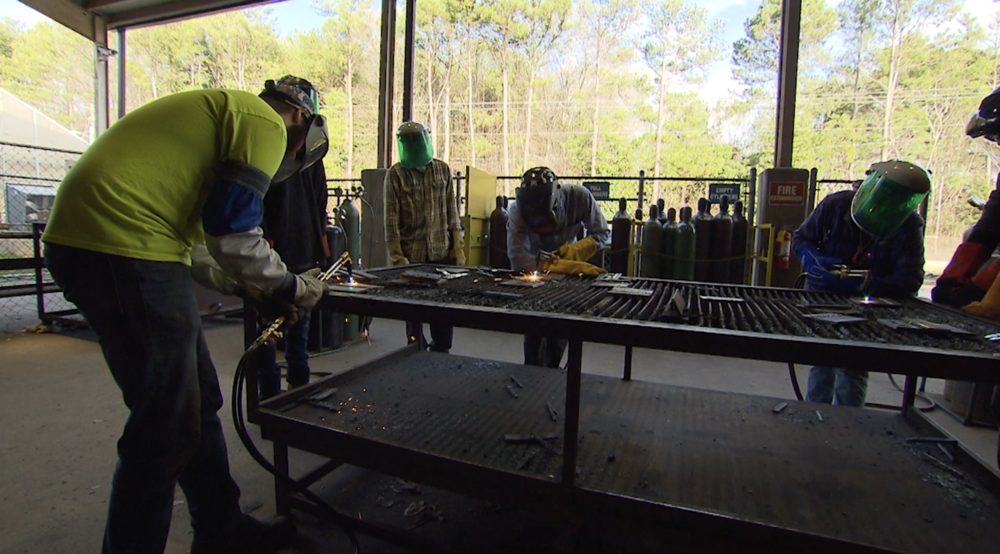Section Branding
Header Content
Students Grateful For Dual Enrollment As Program Faces Budget Cuts
Primary Content
Senior Mai Brown has already taken some of the general college classes required to graduate from a university, even before starting college. The 17-year-old film enthusiast enrolled at the Central Educational Center because she hopes to be a director one day and wants to focus on the classes that will matter to her craft.
“I took a lot of classes over the summer to make my senior year a lot easier and so that I could focus on my career,” she said.
In the building next to Brown’s, after perching over his welding station for an hour, Zach Taylor takes off his eye mask and gloves before leaving his high school classroom for the day. Even though Taylor is a sophomore, he’s enrolled as a welding student at both the Central Educational Center and West Georgia Technical College so he can earn college credit, too.
Both are dual enrollment students at the CEC. Being able to take high school and college classes at the same time has been an advantage to both Taylor and Brown. But if House Bill 444 is passed this legislative session, only students in programs like Taylor's will be able to take full advantage of the dual enrollment program.
Dual Enrollment students can take credit hours in core subject areas such as English, language arts or math without having to pay for college textbooks or tuition, making it a popular choice for both students and their parents.
CEO Mark Whitlock said more than 50,000 students currently take part in the college and career academy program. According to Georgia Student Finance Commission data, approximately 9% of public high school students took dual enrollment courses in 2019.
Thousands of students have completed large parts of their degree requirements even before beginning their college careers. Evolved over the years, since being introduced in 1992, the program has gained popularity in the last decade, costing the state millions of dollars.
This session, the house is looking to House Bill 444 to mitigate some of these costs, by putting academic credit limits on students in certain programs. Students like Brown would be limited in hours of academic credit and, most likely, unable to get as many core classes out of the way.
The bill, sponsored by Rep. Bert Reeves, would cap students to a total of 30 college credit hours and would limit the program to high school juniors and seniors, with certain exceptions.
Lawmakers said with the increasing demand in joining the program, the cost to the state is rising exponentially, as well, and House Bill 444 aims to stop the flood of money. Rep. Rick Jasperse, who is also Chairman of the House Education Committee, said costs have jumped from $23 million in 2015 to nearly $140 in 2018.
“So, what has happened in this case is [that dual enrollment has] escalated cost to set government," Jasperse said. "It is the fastest growing part of the budget. I think everyone realized that as a budget grows, we need to put a cap on it."
Taylor’s welding program is safe from those restrictions. There is a need for dual enrollment in some instances, like the manufacturing and welding programs, Whitlock said.
“Dual enrollment is such a key piece of what our employers ask for," Whitlock said. "What they told us back in 2000 when we were developing this was that we need a student who by age 18 has a much higher level of technical skill. We are seeing that student come out of our technical college system, but at the average of around 27. We need them much more rapidly than that.”
Employers, he said, are recruiting directly at high schools from programs such as the one Taylor takes part, making the welding program safe under SB2 — the Option B Diploma, which will allow those students a much higher cap at approximately 90 hours.
The proposed cap in enrollment would aim to keep the program within its roughly $100 million budget for Fiscal Year 2021, officials said, receiving support from Gov. Brian Kemp as he seeks to reduce the state budget.
The bill passed out of the Senate by a 34-18 vote and is in the House of Representatives.
Taylor said he knows he’s fortunate to be in the program however long it remains an option for students.
“I feel like I am more ahead of my peers in the sense that I am basically in college right now and I am doing what I want to do when I graduate," he said. "And hopefully I will be able to get a job as soon as I am done with this program."


